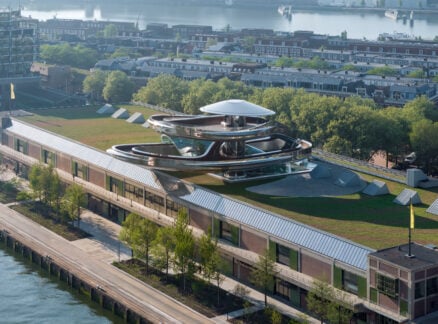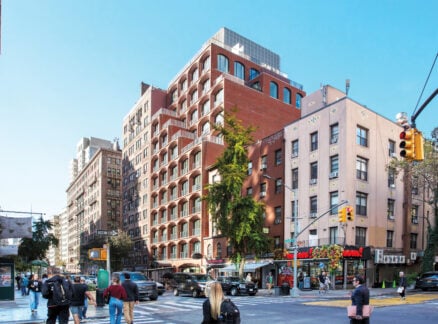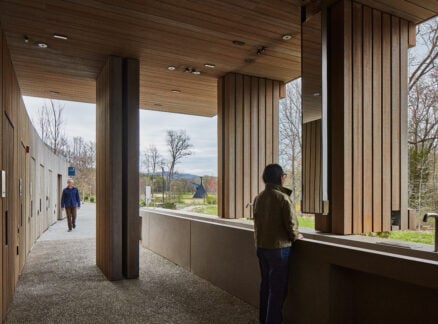October 9, 2009
Q&A: Gail Vittori on the Green-Hospitals Imperative
Our executive editor talks to one of the seminal figures in the greening of American health care.
Gail Vittori and Pliny Fisk III, directors of the Center for Maximum Potential Building Systems
Emilio Ambasz’s claims not withstanding, no one person can declare themselves the father (or mother) of sustainable building. It was clearly a group effort. The same, of course, can be said for green hospital design. But one of the seminal figures there is Gail Vittori, co-director (with her husband, Pliny Fisk III) of the Center for Maximum Potential Building Systems, in Austin, Texas. Vittori served as chair of the U.S. Green Building Council’s LEED for Healthcare committee and co-authored (with Robin Guenther) Sustainable Healthcare Architecture (Wiley). Recently I talked to Vittori about the challenges and the imperative of green hospitals.
What’s the state of sustainable health care? Is the term still an oxymoron?
Because of its regulatory requirements, its 24/7 operations, and the specific nature of what it does, health care was slow to pick up on sustainability. It really does operate as a unique segment within the architecture and building world. But with the introduction of the Green Guide for Health Care and the knowledge that LEED for Healthcare is in development, all of that has provided a structure for people within the industry to understand that “green” and “health care” is not only a good fit, but an imperative.
Did the evidence-based design movement helped spur green health care?
It helped establish a relationship between buildings and outcomes. What we’re seeing now is a dimension that says, “Yes, evidence-based design is significant and should be a major driver. But the range of evidences that we’re viewing as important should extend beyond, say, rates of infection or recovery times.” I think sustainable buildings add an important and complementary dimension.
As we can see from the raucous health-care debates now, it’s a very difficult sector of the economy to reform. How do you move it in a green direction?
It’s important to connect mission to built-environment values. That’s a way to start the conversation and to embed a new method of thinking that could be a departure from the way health-care decisions were made in the past. I really value the significance of pulling people together during those initial integrated design charettes and saying, “What is this project about? Where’s the opportunity for us to make this building a reflection of our values, and how do they align with our mission?” Health care is very well-positioned to have that conversation.
Hospitals can take six, eight, ten years to design and complete. How do you make sustainability a priority when you’re wrangling with such beastly lead times?
In projects that extend that long, it’s important to be conscious of how design decisions influence operational realities. Whether it’s about recruitment and retention, or something much more bottom-line like how much money we’re going to be spending on energy next year. That’s especially significant given the energy intensity of health-care facilities. It’s important to engage head-on the questions that arise about risk, because health-care facilities operate on very slim margins. They’re afraid of change because it can result in risk and uncertainty. And right now while the industry is risk averse, it has patterns of operation that are troubling in terms of hospital-acquired infection and [medical air rates]. So it’s a paradox: how do you introduce change when there’s such resistance to it, but at the same time such need for it? Still, there are a number of institutions that have exhibited a high level of environmental stewardship, but they also say: “We need to do this and we will do it without having a price tag that’s unacceptable.”
For commercial and institutional buildings, the next frontier in sustainable building is the carbon-neutral footprint. Is there an equivalent for green hospitals?
Interestingly, there actually is a health-care system that has set a goal for being carbon-neutral by 2015: Gundersen Lutheran, in Wisconsin.
What would you need to do to create a carbon-neutral hospital? I’d assume you’d have to make a lot of your own electricity?
Well, yes. It would be a combination of on-site generation. But that becomes meaningful when you right-size your energy loads. A combination of factors would support a carbon-neutral achievement. The National Health Service, in the U.K., has also set carbon-neutrality goals for their building portfolio and has done a lot of work in understanding their carbon footprint. That includes factors beyond energy use, such as their supply chain and transportation. That’s an initiative that has a lot of traction right now, and it’s helping to set the pace for others.
If a hospital president came to you and said, “We want you to help us build an ultra-green hospital,” what would be your first step?
The first step? Again, I would establish a correlation between the organizational mission and the related goals associated with the built environment. Once you put health as a central cog in this effort, a lot of stuff comes into focus really fast. Also related to that is understanding the many dimensions of the business case.
Making the economic case for green building?
Absolutely. Health care is dominated by owner-occupied facilities, and we must make that step from understanding first-cost implications with life-cycle cost implications. Now we know that’s two pots of money, but it’s crucial for someone in a CEO position to say: “That extra fifty cents per square foot or a dollar per square foot is going to give us such a significant return over many years, both in terms of the operational expense and the other factors such as recruitment and retention and patient lengths of stay.” Quite frankly, I think the ultimate argument is: to be competitive, this is an imperative.
.
Related: Sam Martin profiled Vittori and Fisk for our 2006 Visionaries Issue. In September, we deconstructed Anshen+Allen’s Green Patient Lab, a full-scale mock-up of a hospital room that demonstrates innovative approaches to sustainable health care. In the same issue, Suzanne LaBarre profiled Emilio Ambasz, the self-proclaimed father of sustainability, who recently completed a pair of medical facilities near Venice.





